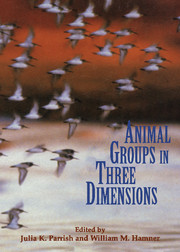Book contents
- Frontmatter
- Contents
- List of contributors
- Acknowledgments
- 1 Introduction – From individuals to aggregations: Unifying properties, global framework, and the holy grails of congregation
- Part one Imaging and measurement
- Part two Analysis
- 7 Quantitative analysis of animal movements in congregations
- 8 Movements of animals in congregations: An Eulerian analysis of bark beetle swarming
- 9 Individual decisions, traffic rules, and emergent pattern in schooling fish
- 10 Aggregate behavior in zooplankton: Phototactic swarming in four developmental stages of Coullana canadensis (Copepoda, Harpacticoida)
- Part three Behavioral ecology and evolution
- Part four Models
- References
- Subject index
- Taxonomic index
7 - Quantitative analysis of animal movements in congregations
from Part two - Analysis
Published online by Cambridge University Press: 01 June 2010
- Frontmatter
- Contents
- List of contributors
- Acknowledgments
- 1 Introduction – From individuals to aggregations: Unifying properties, global framework, and the holy grails of congregation
- Part one Imaging and measurement
- Part two Analysis
- 7 Quantitative analysis of animal movements in congregations
- 8 Movements of animals in congregations: An Eulerian analysis of bark beetle swarming
- 9 Individual decisions, traffic rules, and emergent pattern in schooling fish
- 10 Aggregate behavior in zooplankton: Phototactic swarming in four developmental stages of Coullana canadensis (Copepoda, Harpacticoida)
- Part three Behavioral ecology and evolution
- Part four Models
- References
- Subject index
- Taxonomic index
Summary
Introduction
Most animals spend part or all of their life in groups (Pulliam and Caraco 1984). Gregarious behavior can strongly affect individual fitness, as well as spatiotemporal dynamics of populations (Allee 1931; Hamilton 1971; Thornhill & Alcock 1983; Taylor 1986; Part IV of this book). Quantitative analyses of gregarious movement behaviors, however, are rare (Turchin 1989a). In population ecology, for example, most theoretical analyses assume a contagious, or clumped distribution of organisms (often summarized by a single number, e.g. the variance to mean ratio), without attempting to examine behavioral mechanisms by which organisms clump together.
This bias is partly due to the intrinsic difficulty of studying movement, and partly to our limited understanding of how individuals interact within aggregations. It is often difficult to collect data on the spacing and movements of individuals in aggregations, especially in large three-dimensional aggregations such as bird flocks, fish schools, and insect swarms. Recent advances in instrumentation (reviewed in Part I) are beginning to address this problem. However, even when data are available, innovative methods of analysis are needed to test hypotheses about how aggregations are formed, and to build dynamical models of aggregation structure.
Movement by organisms is most generally defined as a change in an organism's spatial position over time. Thus, by its nature, the process of movement involves two scales – a temporal and a spatial. Because the description of spatial position typically involves two or three coordinates, a description and an analysis of movement has to be multidimensional (3-D for most terrestrial organisms, and 4-D for aquatic, aerial, arboreal, etc., organisms).
- Type
- Chapter
- Information
- Animal Groups in Three DimensionsHow Species Aggregate, pp. 107 - 112Publisher: Cambridge University PressPrint publication year: 1997
- 6
- Cited by



